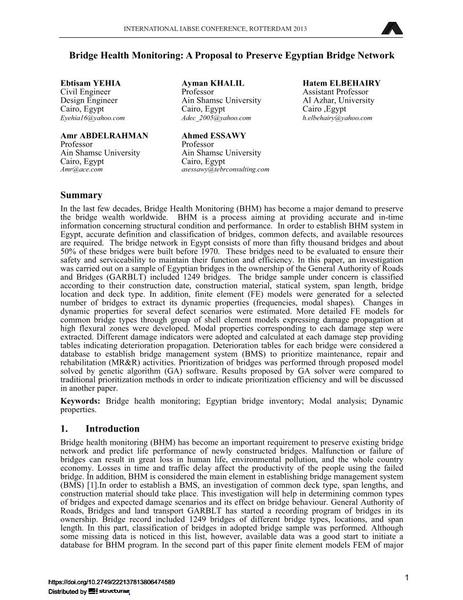Bridge Health Monitoring: A Proposal to Preserve Egyptian Bridge Network

|
|
|||||||||||
Bibliografische Angaben
| Autor(en): |
Ebtisam Yehia
Ayman Khalil Hatem Elbehairy Amr Abdelrahman Ahmed Essawy |
||||
|---|---|---|---|---|---|
| Medium: | Tagungsbeitrag | ||||
| Sprache(n): | Englisch | ||||
| Tagung: | IABSE Conference: Assessment, Upgrading and Refurbishment of Infrastructures, Rotterdam, The Netherlands, 6-8 May 2013 | ||||
| Veröffentlicht in: | IABSE Conference, Rotterdam, May 2013 | ||||
|
|||||
| Seite(n): | 154-155 | ||||
| Anzahl der Seiten (im PDF): | 8 | ||||
| Jahr: | 2013 | ||||
| DOI: | 10.2749/222137813806474589 | ||||
| Abstrakt: |
In the last few decades, Bridge Health Monitoring (BHM) has become a major demand to preserve the bridge wealth worldwide. BHM is a process aiming at providing accurate and in-time information concerning structural condition and performance. In order to establish BHM system in Egypt, accurate definition and classification of bridges, common defects, and available resources are required. The bridge network in Egypt consists of more than fifty thousand bridges and about 50% of these bridges were built before 1970. These bridges need to be evaluated to ensure their safety and serviceability to maintain their function and efficiency. In this paper, an investigation was carried out on a sample of Egyptian bridges in the ownership of the General Authority of Roads and Bridges (GARBLT) included 1249 bridges. The bridge sample under concern is classified according to their construction date, construction material, statical system, span length, bridge location and deck type. In addition, finite element (FE) models were generated for a selected number of bridges to extract its dynamic properties (frequencies, modal shapes). Changes in dynamic properties for several defect scenarios were estimated. More detailed FE models for common bridge types through group of shell element models expressing damage propagation at high flexural zones were developed. Modal properties corresponding to each damage step were extracted. Different damage indicators were adopted and calculated at each damage step providing tables indicating deterioration propagation. Deterioration tables for each bridge were considered a database to establish bridge management system (BMS) to prioritize maintenance, repair and rehabilitation (MR&R) activities. Prioritization of bridges was performed through proposed model solved by genetic algorithm (GA) software. Results proposed by GA solver were compared to traditional prioritization methods in order to indicate prioritization efficiency and will be discussed in another paper. |
||||
| Stichwörter: |
Modalanalyse
|
||||
